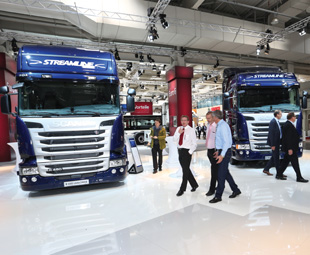Hail the commercial vehicle!

I love commercial vehicles! And this year’s IAA left me with a truly warm and fuzzy feeling about the vehicles that we write about within the pages of FOCUS …
You’ll read a lot about the IAA in this issue of FOCUS. That’s because the 2014 fair lived up to its reputation for being the world’s leading commercial vehicle show – once again. The who’s who of the global commercial vehicle industry converged on Hannover for ten days (including two press days) to natter and view the latest and greatest innovations.
Everyone was in an upbeat mood, including the eternally jovial Matthias Wissmann, president of the German Association of the Automotive Industry (VDA), which organises the fair. It was easy to understand why; this year’s event attracted 2 066 exhibitors from 45 countries.
But Wissmann had more to beam about than the success of the actual fair; as he aptly pointed out, the industry as a whole is doing a dandy job. “No other means of transport has made quantum leaps in recent years like the commercial vehicle – it is genuinely bundled technology on wheels,” he noted.
Those commercial vehicles do more than just move goods and people. “No matter whether in large or small businesses, or in urban or rural regions, from the North Sea to the edge of the Alps, one thing is clear: commercial vehicles ensure prosperity and jobs.
“In Germany, around 190 000 direct employees give of their best, day by day, in the production of commercial vehicles. That is one quarter of all employees in the automotive industry. Then there are also the employees whose jobs depend indirectly on commercial vehicles – in operations, maintenance and deployment. Of course, this includes the vehicle’s best friend, the driver!” Wissmann added.
The VDA president went on to say that both national and international freight traffic would continue to increase in the future. All modes of transport would be needed for coping with the growing volume. “Trucks, the railways and ships must all do what they do best. They have to be networked in the best possible way to keep on making transport more efficient,” he stressed.
Wissmann added, however, that commercial vehicles were “unbeatable”, especially on short and medium-length routes: 78 percent of all road freight is transported over distances of less than 150 kilometres.
“Commercial vehicles make roughly 2,7 billion courier, express and parcel deliveries every year. One thing applies equally to books and shoes, items bought as gifts or for one’s own use: no other mode of transport is better suited to the rapidly growing mail-order business, than commercial vehicles. They serve society reliably and unobtrusively. Commercial vehicles truly are quiet heroes with no airs and graces,” Wissmann stated.
Public passenger transport, too, would be inconceivable without road transportation, the VDA president stressed, and continued: “Every year buses carry over five billion passengers to their destinations – which is 43 percent of the total volume carried by buses and railways.”
He added that coaches were writing an “extraordinary success story”. In the first eight months of this year, they transported over ten million passengers, and the figure could exceed 15 million by the end of the year. At the same time, buses are real CO2 champions: a fully laden bus consumes less than one litre of fuel per passenger per 100 km.
Today emissions of pollutants from a modern Euro-6 truck are up to 98 percent less than those from a truck 25 years ago. Compared with the previous Euro-5 standard, nitrogen oxide emissions have come down by 80 percent, while particulates have been reduced by around two thirds.
“So the commercial vehicle manufacturers have successfully carried out the historic task of reducing pollutants to almost zero. We are now concentrating on further decreases in fuel consumption and CO2 emissions. In this area we have already made great strides forward. Today a 40 t truck-trailer combination consumes around 60 percent less fuel, per tonne-kilometre, than a truck did in the mid-1960s. Achieving that required a technological tour de force with high levels of investment – it certainly wasn’t a walk in the park,” Wissmann emphasised.
A walk in the park it was most certainly not. But cause for celebration? I think so. Hail the commercial vehicle!
Published by
Focus on Transport
focusmagsa




